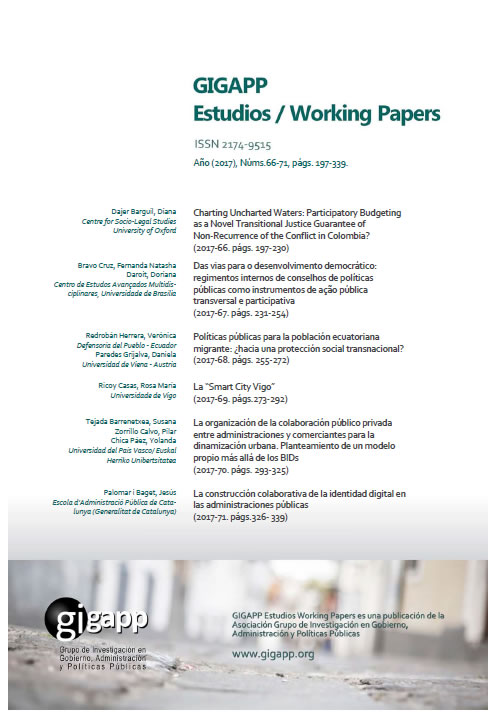From the path to democratic development: internal rules of public policy councils as instruments of public action and participatory
Resumen
In order to analyze how public action instruments engender participatory institutions, processes of representation and democratic construction, taking into account multiple sectors, segments, origins, groups and institutions, we observe meetings and, more especially, internal regiments of the Brazilian National Councils for Health, Human Rights and the Environment Environment, analyzing their roles in the production of dialogical relations between different groups. As a theoretical-analytical support, the notions of hybrid forum, public action and instruments (Callon, Lascoumes, Barthe, 2009; Muller, 2013; Las Galmes, Le Galès, 2004, 2012; Halpern, Lascoumes, Le Galès, 2014). From the 1988 constitution, and with a rise in the early 2000s, the Brazilian national councils have been recomposed as emblematic and ambiguous forums between a new paradigm for democracy and development and the preservation of past models.
Descargas
Derechos de autor 2017 Fernanda Natasha Bravo Cruz

Esta obra está bajo licencia internacional Creative Commons Reconocimiento-NoComercial-CompartirIgual 4.0.
Aquellos autores/as que tengan publicaciones con esta revista, aceptan los términos siguientes:
a. Los autores/as conservarán sus derechos de autor y garantizarán a la revista el derecho de primera publicación de su obra, el cuál estará simultáneamente sujeto a la Licencia de reconocimiento de Creative Commons Attribution-NonCommercial-ShareAlike 4.0 International (CC BY-NC-SA 4.0) que permite a terceros compartir la obra siempre que se indique su autor y su primera publicación esta revista.
Con esta licencia de acceso abierto, los lectores (usuarios) pueden:
- Compartir — copiar y redistribuir el material en cualquier medio o formato
- Adaptar — remezclar, transformar y construir a partir del material
Bajo los siguientes términos:
-
Atribución — usarios deberán dar crédito de manera adecuada, brindar un enlace a la licencia, e indicar si se han realizado cambios. Puede hacerlo en cualquier forma razonable, pero no de forma tal que sugiera que usted o su uso tienen el apoyo de la licenciante.
-
NoComercial — usuarios no puede hacer uso del material con propósitos comerciales.
-
CompartirIgual — Si remezcla, transforma o crea a partir del material, usuarios deben distribuir su contribución bajo la misma licencia del original.
-
Sin restricciones adicionales: los usuarios no pueden aplicar términos legales o medidas tecnológicas que restrinjan legalmente a otros de hacer cualquier cosa que permita la licencia.
b. Los autores/as podrán adoptar otros acuerdos de licencia no exclusiva de distribución de la versión de la obra publicada (p. ej.: depositarla en un archivo telemático institucional o publicarla en un volumen monográfico) siempre que se indique la publicación inicial en esta revista
c. Se permite y recomienda a los autores/as difundir su obra a través de Internet (p. ej.: en archivos telemáticos institucionales o en su página web) antes y durante el proceso de envío, lo cual puede producir intercambios interesantes y aumentar las citas de la obra publicada. (Véase El efecto del acceso abierto).



